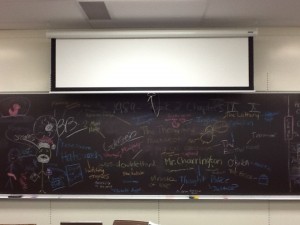NCTE11 News and Notes 2
December 13, 2011 by GradingGirl
Filed under Achieving Assignments, Mini-Lessons
Need some inspiration during these last few days before Winter Break?! While the following post does not give the NCTE 11 session, National Literature Project, nearly enough justice, I’m sharing a few inspirational tidbits that continue to stick with me since attending a month ago. I continue to be inspired . . . 
~ Meaning is neither in the text nor the reader. It is in the transaction.
~ Literature helps us work out our relationship with the world around us. Students have this experience all the time with games, movies, etc. We can help them see that they can get just as lost in literature!!
~ “Unless you are educated in metaphor, you are not safe to be let loose in the world.” Robert Frost
~ NAEP reading framework – % of Literature vs. Informational text: 4th grade – 50%, 8th grade – 45%, 12th grade – 30%
~ Young people betweeen the ages of 8 – 18 are using entertainment media 7 hours, 38 minutes a day!!
~ HOW they read matters much less than HOW MUCH they read!!!! (in other words, the video game magazines are helping their reading as well!!!)
~ Background knowledge only builds from reading.
~ A student, on average, takes 7 seconds to look at a painting and 36 seconds to read a plaque. In other words, students are much more likely to interpret visuals freely rather than interpret written text. Students are visual these days!!!!
~ Reading is a way to have tea with an author. 🙂
~ All teaching and learning is relational. We are creating culture and knowledge!!
______________________________________________________
Lesson idea:
A. Write a note to one your favorite authors or teachers. Include some highlights of that relationship, influences, insights gained because of the relationship, great moments, etc. Perhaps explore how you have grown with/because of this teacher or author. How has this author/teacher transformed your thinking?
B. Exchange letters with your neighbor. Cirle words that seem to capture the relationship highlighted in your neighbor’s letter.
C. Use those circled words to create a poem
D. Once poems are written, ask for volunteers to stand in a line in front of the class. One at a time, the standing students read one line from their poems. The teacher (with the help of the students) will move students around to create a “class” poem; place students in the order of lines that build upon one another.
E. Finally, read the final poem
The moral of this lesson . . . the power of attachment is so much greater than detachment.
“Produce great persons. The rest follows.” ~Walt Whitman
NCTE11 News and Notes
November 23, 2011 by GradingGirl
Filed under Achieving Assignments, Mini-Lessons
My school district afforded me the wonderful opportunity to attend my very first National Council of Teachers of English conference held in Chicago, Illinois this year. I met wonderful national colleagues, many of whom I’ve been conversing with online but never had the opportunity to meet face-to-face, and I returned to school feeling completely motivated and recharged.
The following is a sampling of tips from a session titled “Zapping Apathy: Creating a Sense of Community in English Class” Please see Gary Anderson’s informative blog, What’s Not Wrong, for more detailed information:
1. Build Community Through Movement: Chalk Talk: A silent, non-threatening way to generate ideas, spawn discussion, understand connections. Here’s my students’ first 1984 Chalk Talk. (see my sample in picture)
2. Build Community Through Online Means: 6-Word Memoirs with Wordle: A team-building, creative writing activity. First, show the following two YouTube videos – First video and Second Video. Second, students write their own six-word memoirs. Third, have students go to www.wordle.net and create and a visual of their memoirs. They’ll be able to play with font, color scheme, etc to fit their subject and make it come to life.
3. Build Community through Cell Phone Activity (shared by Lee Anne Spillane): Did you know that if students text Google, 466453, and punch in Define: (followed by the word), Google will text back a definition of that word?!
4. Build Community through Discussion – A means to get the quieter students involved. Provide envelopes filled with slips of paper numbered 1 – 10. Give these envelopes to about 4 students and have those students stand in front of class. Read a statement and ask students to hold up a slip that represents how strongly they agree with the statement.(1 = strongly disagree; 10 = strongly agree)
Like these samples? . . . see Gary Anderson’s What’s Not Wrong site for more along with the original handouts and Prezi’s from the session.
**************************************************************************************************************************
There are so many more worthwhile sessions I attended. For instance, stay tuned for a synopsis of Carol Jago’s Literature Project!!!!
Symbols, Signs and Slides
November 7, 2011 by GradingGirl
Filed under Achieving Assignments, Mini-Lessons

Whether or not you are an educator, viewing the two videos below will be worth your while. Sit back and enjoy the symbolism within our daily lives. . . .
Here is an assignment I recently shared with my two accelerated freshman English classes. We have a rigorous curriculum to follow in the classroom yet I wanted to give the students opportunity to express their more creative sides. I came up with this to supplement our study and analysis of symbolism. Aside from the period during which we watched and discussed “Words”, this is a project they had to complete solely at home on their own. The student sample below is just one example of how well they ran with this!
ASSIGNMENT:
In conjunction with our study of “The Scarlet Ibis” and symbolism, watch this video from NPR’s Radiolab to help illustrate how images are contextual. You will complete an assignment afterwards, but first I just want you to watch and enjoy it:
Now search for the word semiotics and define it. Watch the video again with that definition in mind. As you watch, write down all of the words presented through the images and sound in the video. We will discuss how the varied definitions of these words match the context within which they are shown.
For the end result, you are going to create your own video. You will need to decide on eight words of your choosing. Four of the eight words must be from our most recent vocabulary list. You must find at least two different meanings for each word and at least one image to represent each meaning.
Use PhotoPeach, MovieMaker or another program of your choice. In addition to production of your slideshow, provide a “key” that highlights which words you used along with an explanation of the word definitions. Happy producing!!!
STUDENT SAMPLE:
Click here to watch: Student Sample
STUDENT’S ANSWER KEY:

